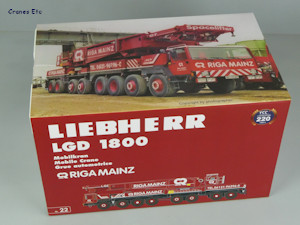 |
| Attractive
picture sleeve.
|
 |
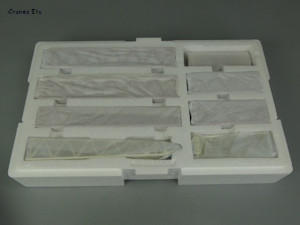 |
| Middle tray. |
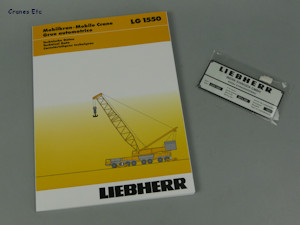 |
| Brochure and
collector plate. |
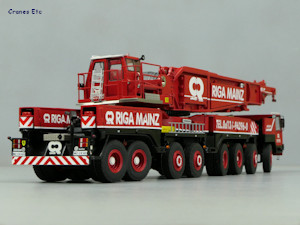 |
| Reasonable
steering lock. |
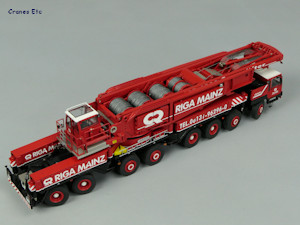 |
| Rope has a
realistic 'new' look. |
|
|
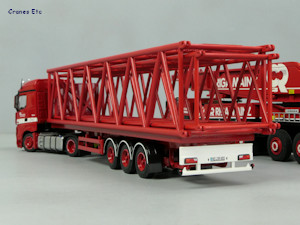 |
| Booms can be
telescoped for transport. |
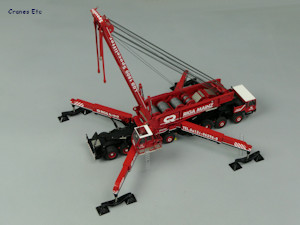 |
| Erection
underway. |
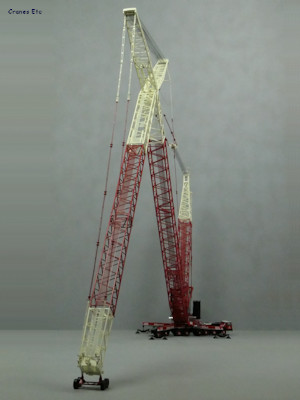 |
| Luffing jib and
derrick. |
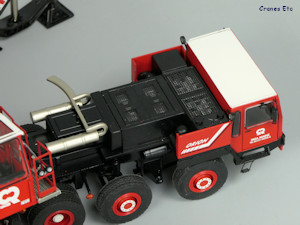 |
| Fans visible
under the grilles. |
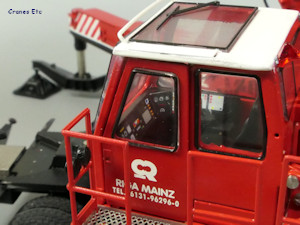 |
| Very detailed
crane cab.
|
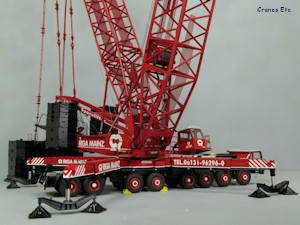 |
| Heavy crane. |
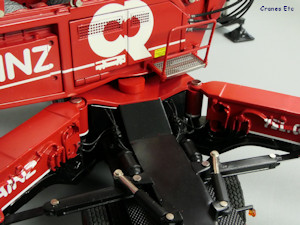 |
| Highly detail
with hydraulic hoses on the outriggers.
|
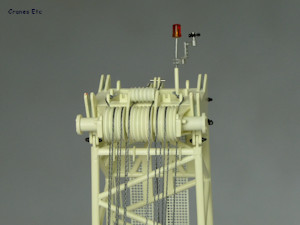 |
| Warning light
and anemometer. |
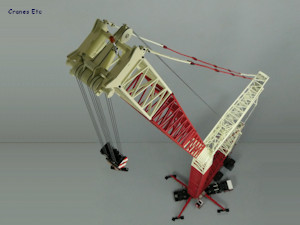 |
| Excellent
geometry. |
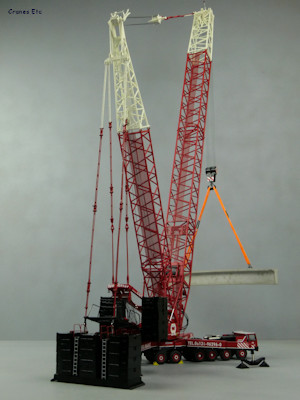 |
| Lifting a
bridge beam. |
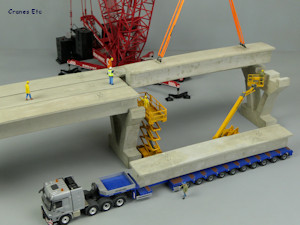 |
Looks great in
a mini diorama with realistic bridge beams.
|
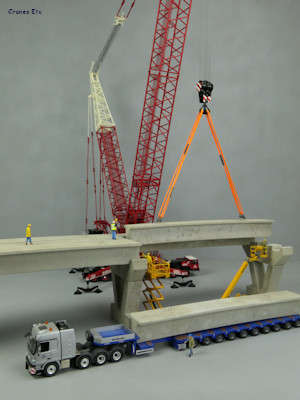 |
| Impressive. |
|

The real version of the Liebherr LGD 1800 modelled here
was built in 1993 and was owned by the German company
Riga
Mainz, which was founded in 1929.
Packaging
The model comes in an outer shipping carton, and inside
it a large picture sleeve encloses three expanded polystyrene
trays and lid. The trays are clipped together with
plastic formers which is a much better system than using
sticky tape.
The model parts are individually wrapped in soft paper.
There were no missing parts on the review model. One part
was not assembled correctly and was replaced.
The model is a limited edition of 220 pieces. A metal
collector plate is included which has a unique serial number,
and on one side is a representation of the Liebherr plate
from the real crane - a very nice touch.
A brochure is included. It begins with a reprint
of Liebherr technical data, complete with loading charts.
It is followed by model information including assembly photos
and diagrams. A separate sheet was supplied containing
the A-frame reeving diagram, but one omission is a full
parts list. Smaller parts such as the various bolts are
provided in individually labelled bags.
Assembly of the model is reasonably straightforward and
the fit of the parts is very good. The brochure describes
the main information well but leaves out some of the smaller
parts. Depending on the configuration, quite a few
hours should be allowed to build the model, and as usual
the slowest part is reeving where, as always, patience and
a methodical approach is needed.
Detail
The underside of the carrier is excellent with very good
transmission and suspension components detailed. The
metal wheel hubs look very good, being of two types as per
the original, and mounted with excellent tyres bearing the
‘Michelin’ logo on the outside.
The driving cab has very finely made windscreen wipers and
mirrors, and intricate steps to the cab. Inside the
cab the console and instruments are detailed.
Detail behind the cab continues at an excellent level.
Mesh grilles allow the fans underneath to be seen. The
exhaust system is very good too. At the slewing ring
hydraulic cabling runs to the outrigger beams. Along both sides
of the carrier are small orange lights
which sit at the end of thin stalks. Wheel chocks
and a ladder can be fixed on each side.
At the rear there are detailed light boards and there is
a lifting gantry, although this version of the crane did
not carry a spare wheel.
The outrigger beams are beautifully made. The inner
sections have excellent hydraulic line details within the
castings and the two stage beams are metal and feel very
solid. At the end the pistons screw down to the transverse
pad beams without revealing any unsightly screw thread.
The spreader beams and pads are first class. They
are all metal and very well detailed. Better still,
they contain magnets which allow the pads to stick to the
beams and the beams to stick to the pistons which is really
an excellent design.
The high quality continues into the crane body. The
cab windows have fine seals and windscreen wipers.
Inside, the controls are clearly seen, and outside there
are excellent grab rails and mesh walkways. Alongside
the body the panels have fine details within the casting
including hydraulic lines. Inside the body the winch
drums are well detailed, and the supplied rope has a realistic
'new steel' colour. The pulleys used are metal and are painted
to match the crane colour so look very good indeed. The
boom A-frame is raised by excellent metal three stage
cylinders which have ingenious magnet connections to the
gantry. At the A-frame head there is a hydraulic lift
cylinder and top quality metal pendant connections.
Tiny adjustable lights are also detailed.
On each side of the body access platforms can be fitted
when the crane is being used. These have very good mesh
floors, although the hand rails are plastic and because
they are thin, they are delicate. These parts press fit
into holes in the body although they are easily knocked
off, and difficult to get straight.
The counterweight tray has lifting points cast in and the
counterweight slabs are first rate also, with each one having
excellent lifting points and the Liebherr name and weight
clearly visible within the casting detail. Sets of
chains and associated clips and pins are provided to enable
the counterweight slabs to be secured, and these add to
the detail.
The superlift counterweight looks very good and has nice
access platforms and working rollers. The lift cylinders
are finely detailed.
The boom butt section has fine metal mesh walkways and there
are very nice rollers for allowing ropes to run smoothly.
Two small spools are contained within the boom section and
there is hydraulic cabling running from the winch which
can be secured into the body.
The lattice section connections uses small plastic split
pins for joining the sections. The main boom and jib
sections are dead straight, and have
mesh walkways and internal bracing. The smaller sections fit nicely inside the
larger sections so simulating
accurate transport loads is possible.
The boom, derrick and head sections are very well made
with metal pulleys throughout. Even the short reducer
boom section has a working roller, and eyes for fitting
a direct connection to the pendants for long boom
lengths, and the connectors are supplied with the
model. Also included is a rooster head and this
difficult section is superbly made with a folding line
pulley and tiny rollers to enable this piece to roll on
the ground if needed during erection.
The pendants are very finely made. All in metal, they
look extremely convincing and use very small plastic
split pin bolts, similar to those used to join boom
sections. The main boom luffing bridle is superbly
detailed with lifting shackles and a useable erection
hook.
A nice touch is the anemometer and aircraft warning
light which can added to the boom or jib head.
Two hook blocks are supplied with the model and this gives the collector
flexibility in rigging the crane. One is a larger
double block and the other is a small block. Each one is
excellent. They have metal sheaves
and very good hooks complete with safety catches.
A four wheeled dolly is included to support the luffing
jib head during erection and it is a nicely made part.
Features
The steering on the carrier is good with axles 1 to 4 and
7 and 8 steering like the original, although the
mechanisms were loose on the review model. A reasonable lock
can be obtained. Not all the wheels were fully grounded
on the review model.
The carrier cab has opening doors. They are fitted
with tiny magnets which secure the doors in the closed
position.
The outrigger beams pull out laterally from the carrier
to form a star shape and can be telescoped out smoothly
to maximum extension or alternatively the model can be posed
with shortened outrigger beams like the original.
The pistons screw down smoothly to replicate a pinned bearing
connection on the transverse beams.
The crane cab is a swing away type which tucks in at the
front when in transport mode. It can also be tilted
to allow the operator comfort when the crane is lifting
at height. Alternative windscreens can be fitted
for transport or working model. The door slides
open although it is fiddly. A delicate fold down ladder is also modelled.
A working hydraulic erection hook is provided on the
A-frame and it is stiff enough to hold a reasonable
load.
The crane rotates smoothly, even under load.
The crane body has four winch drums and these are
accessed by using removable magnetic side panels on the
body. This excellent design feature allows the model to
be operated without having unsightly access holes in the
side of the body. Each winch is stiff enough to hold
any reasonable load, and they are can be operated by
using a special tool which has a slot at the end so it can
be driven by a powered screwdriver. A fifth winch
is contained within the boom foot section and this can be
operated in the same manner.
The main winch functions work well enough.
However, the luffing gear for the fly jib has many runs
of rope and even though the pulleys are free rolling,
rope friction means that manual help is needed to change
the jib angle.
The superlift tray includes lockable tensioning
cylinders.
This is a large model set and it enables many
configurations to be built, and in this regard it is as
flexible as the real crane. It also enables a very large
model to be built reaching up to around 2.8m or 9.5ft.
Quality
This is very high quality model. The metal content
is very high and the quality of manufacture is first
rate.
The finish of the paintwork and the Riga Mainz colour
scheme is excellent. In particular, the
application of the graphics over complicated surfaces is
beautifully done.
Price
Although this is an expensive model, it is unsurprising
that it rapidly sold out. It is worth the cost for
the quality and many parts included.
Overall
This is an excellent model. It is also particularly
impressive that YCC has made numerous amendments and
improvements to earlier versions of it in order to
achieve as authentic a model as possible. It looks
great, and makes for an excellent model display.
Footnotes
The model first appeared in Liebherr colours as model
YCC 780, and it was
reviewed in 2009.
|
|
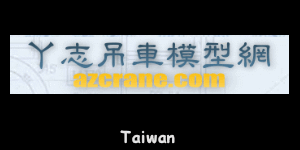 |
|
|
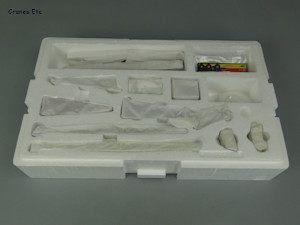 |
| Top tray. |
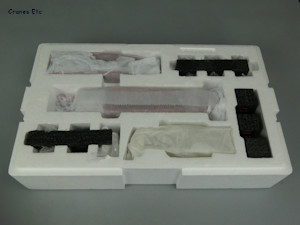 |
| Bottom tray. |
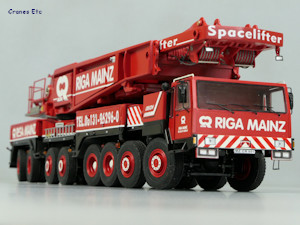 |
| Looks
beautiful. |
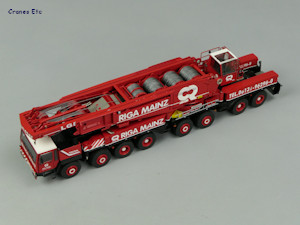 |
| On the road. |
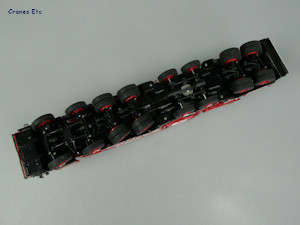 |
| Detailed
underneath.
|
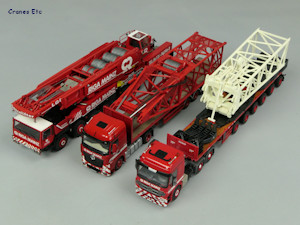 |
| Nice in a
convoy if you have matching trucks.
|
|
|
 |
| Opening doors. |
 |
| Very realistic
boom profile.
|
 |
| Nice dolly
included. |
 |
| Wheel chocks
and assembly inches have rope on the drums. |
 |
| Excellent
outrigger supports. |
 |
| Heavy superlift
tray. |
 |
| Heavy luffing
gear. |
 |
| Configured for
a heavy lift with a YCC coke drum. |
 |
| Realistic. |
 |
| Busy site. |
|

